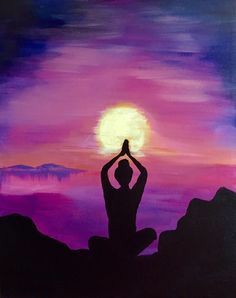
II Sri Adi Śaṅkarācārya - श्री आदि शङ्कराचार्य II
Sōpānaṁ : 11 Meeting Govinda Bhagavatpāda :
सर्व-वेदान्त-सिद्धांत-गोचरं तमगोचरमतमगोचरम।
गोविन्दम परमनान्दम सद्गगुरुम प्रणतोस्म्यहम॥
{Vivekacūḍāmaṇi}
#Thread
Sōpānaṁ : 11 Meeting Govinda Bhagavatpāda :
सर्व-वेदान्त-सिद्धांत-गोचरं तमगोचरमतमगोचरम।
गोविन्दम परमनान्दम सद्गगुरुम प्रणतोस्म्यहम॥
{Vivekacūḍāmaṇi}
#Thread

As Śaṅkarā walked on enquiring the whereabouts of Govinda Bhagavatpāda, the sadhus of Ōṃkārēśvar praised the glory of the Brahmanishtha in superlative terms, reminiscent of the Upanishadic mantra, which says ‘people view with wonder the ‘Brahmajnani’. They showed Śaṅkarā the
cave where he lived. It was in the middle of a hill in a village near Ōṃkārēśvar. Here & there ‘sanyasis’ were found engaged in ‘Sadhana’ & ‘Sastravichara’. Śaṅkarā felt the peace of Brahmanirvana filling the entire area. A Brahmavid is not simply a knower of Brahman, but
Brahman itself. Like fragrance from a flower, silence, tranquility, austerity, renunciation & Truth filled the place where that ‘jivanmukta’ lived.
Śaṅkarā entered the cave & sought permission to meet the sage. With great affection, the sanyasis led him to the presence of the
Śaṅkarā entered the cave & sought permission to meet the sage. With great affection, the sanyasis led him to the presence of the
Guru. There he saw the divine form of the old sage sitting absolutely still with eyelids open & flicker-less. The vision of the sage was effortlessly still, indicating the steady abidance in the Self.He appeared as the embodiment of the Upanishadic description ‘drshti sthira 

yasya vina nirodhat’ - ‘Yogi is one whose vision is effortlessly steady’. See how the Upanishad portrays such a Yogi : ‘tad vishno: paramam Padam sada pasyanti suraya: diviva chakshuratatam’ - ‘The sages always behold the radiant abode of Vishnu in their heart. Outwardly their
eyes have a vacant look as if gazing at empty space.'
Approaching the great master, Śaṅkarā also stood still in awe, beholding d beatific form of d best among d Knowers of Brahman.
ब्रह्मार्पणं ब्रह्म हविर्ब्रह्माग्नौ ब्रह्मणा हुतम् |
ब्रह्मैव तेन गन्तव्यं ब्रह्मकर्मसमाधिना ||
Approaching the great master, Śaṅkarā also stood still in awe, beholding d beatific form of d best among d Knowers of Brahman.
ब्रह्मार्पणं ब्रह्म हविर्ब्रह्माग्नौ ब्रह्मणा हुतम् |
ब्रह्मैव तेन गन्तव्यं ब्रह्मकर्मसमाधिना ||
Meaning :-
“Offered to Brahman, offering is Brahman, the fire is Brahman, the offerer is Brahman & the result merges in Brahman, when action is performed in the state of Self-abidance”.
Just as a genius, out of instinctive talent, imbibes the ‘bhavas’ & ‘mudras’ from a
“Offered to Brahman, offering is Brahman, the fire is Brahman, the offerer is Brahman & the result merges in Brahman, when action is performed in the state of Self-abidance”.
Just as a genius, out of instinctive talent, imbibes the ‘bhavas’ & ‘mudras’ from a
proficient dancer without being trained, Śaṅkarā’s mind grasped & held the profound state of ‘chit’ in the presence of the great Master & anon wore the form of ‘chinmudra’ in the heart.
Such an experience is made possible for a disciple by d power of Consciousness that prevails
Such an experience is made possible for a disciple by d power of Consciousness that prevails

in the presence of a Sadguru.
When a qualified disciple approaches a sage who remains in ‘Sahaja’ state, the inscrutable power of the Self, flowing from the heart of the sage, makes a powerful impact at the core of the disciple’s heart, instantaneously destroying the
When a qualified disciple approaches a sage who remains in ‘Sahaja’ state, the inscrutable power of the Self, flowing from the heart of the sage, makes a powerful impact at the core of the disciple’s heart, instantaneously destroying the
‘hrdaya granthi’ - the knot of Ignorance. This power is known as ‘Kripa’ (Grace).
After a while, the deep eyes of the sage gently flickered. Govinda Bhagavatpāda slowly turned towards the boy & looked at him.
After a while, the deep eyes of the sage gently flickered. Govinda Bhagavatpāda slowly turned towards the boy & looked at him.
Śaṅkarā worshipped the great master with this beautiful ‘sloka’ :
सर्व-वेदान्त-सिद्धांत-गोचरं तमगोचरम।
तमगोचरम। गोविन्दम परमनान्दम सद्गगुरुम प्रणतोस्म्यहम॥
{Vivekacūḍāmaṇi}
The next day, on the banks of the Narmada, the guru initiated the ‘brahmachari’ into ‘Sanyasa’ in
सर्व-वेदान्त-सिद्धांत-गोचरं तमगोचरम।
तमगोचरम। गोविन्दम परमनान्दम सद्गगुरुम प्रणतोस्म्यहम॥
{Vivekacūḍāmaṇi}
The next day, on the banks of the Narmada, the guru initiated the ‘brahmachari’ into ‘Sanyasa’ in
the traditional manner & blessed him.
He was given the name ‘ Śaṅkarā Bhagavatpāda ‘.
Afterwards Śaṅkarā Bhagavatpāda composed ten shlokas revealing the great wealth of experience that he had received in the presence of the Guru.
He was given the name ‘ Śaṅkarā Bhagavatpāda ‘.
Afterwards Śaṅkarā Bhagavatpāda composed ten shlokas revealing the great wealth of experience that he had received in the presence of the Guru.
This is the first Vedantic composition of ācārya Bhagavatpāda, & known as nirvāṇa daśakam or daśaślōkī :-
न वर्णा न वर्णाश्रमाचारधर्मा
न मे धारणाध्यानयोगादयोऽपि ।
अनात्माश्रयाहंममाध्यासहानात्
तदेकोऽवशिष्टः शिवः केवलोऽहम् ॥ २॥

न वर्णा न वर्णाश्रमाचारधर्मा
न मे धारणाध्यानयोगादयोऽपि ।
अनात्माश्रयाहंममाध्यासहानात्
तदेकोऽवशिष्टः शिवः केवलोऽहम् ॥ २॥


Here in the daśaślōkī, Sri Adi Śaṅkarā sums up the essence of Vedanta.
Thus ends the eleventh Sōpānaṁ.`
I ओम् तत् सत् I
I Om Tat Sat I0
Thus ends the eleventh Sōpānaṁ.`
I ओम् तत् सत् I
I Om Tat Sat I0

@RituRathaur @ikkmurugan @Mishti_in @shallakaul @BeenaPP1 @IshaSattva @geetaraavi @armykafan @kachnarr @apparrnnaa @ushanirmala @lokagatha @bangadvedant @aneelgs
• • •
Missing some Tweet in this thread? You can try to
force a refresh





















